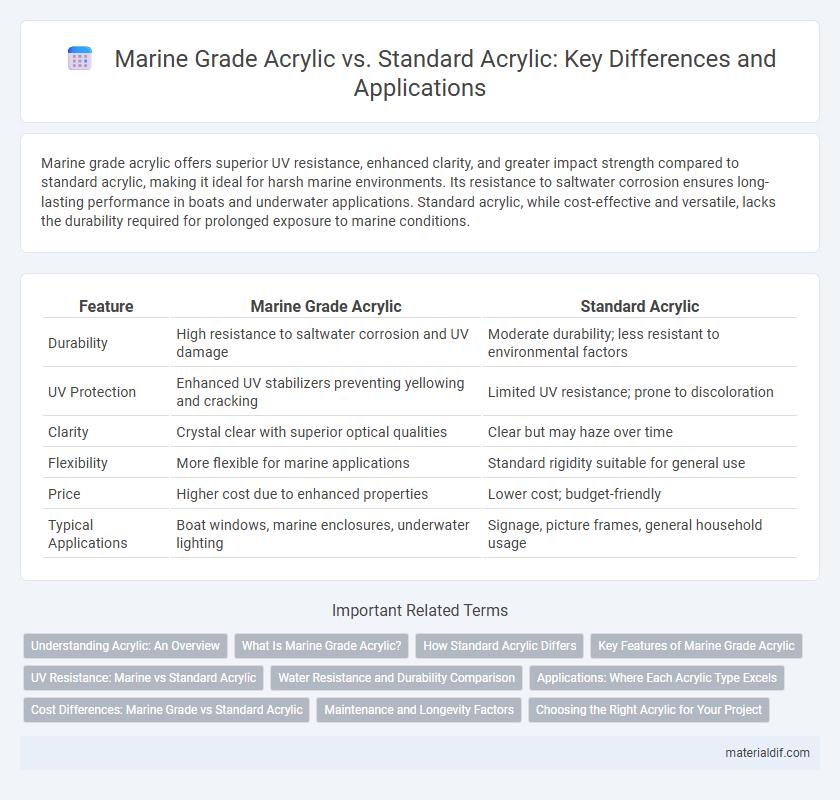Marine grade acrylic offers superior UV resistance, enhanced clarity, and greater impact strength compared to standard acrylic, making it ideal for harsh marine environments. Its resistance to saltwater corrosion ensures long-lasting performance in boats and underwater applications. Standard acrylic, while cost-effective and versatile, lacks the durability required for prolonged exposure to marine conditions.
Table of Comparison
| Feature | Marine Grade Acrylic | Standard Acrylic |
|---|---|---|
| Durability | High resistance to saltwater corrosion and UV damage | Moderate durability; less resistant to environmental factors |
| UV Protection | Enhanced UV stabilizers preventing yellowing and cracking | Limited UV resistance; prone to discoloration |
| Clarity | Crystal clear with superior optical qualities | Clear but may haze over time |
| Flexibility | More flexible for marine applications | Standard rigidity suitable for general use |
| Price | Higher cost due to enhanced properties | Lower cost; budget-friendly |
| Typical Applications | Boat windows, marine enclosures, underwater lighting | Signage, picture frames, general household usage |
Understanding Acrylic: An Overview
Marine grade acrylic offers enhanced UV resistance and superior impact strength compared to standard acrylic, making it ideal for harsh marine environments. Its polished surface maintains clarity over time, resisting yellowing and cracking caused by prolonged sun exposure. Standard acrylic, while versatile and cost-effective, lacks the durability and weather resistance required for aquatic applications.
What Is Marine Grade Acrylic?
Marine grade acrylic is a high-performance plastic specifically engineered for maritime environments, offering superior UV resistance, impact strength, and clarity compared to standard acrylic. It contains enhanced additives that prevent yellowing and degradation caused by prolonged exposure to saltwater, sunlight, and harsh weather conditions. This type of acrylic is commonly used in boat windows, marine instrumentation, and outdoor applications requiring long-lasting durability and optical clarity.
How Standard Acrylic Differs
Standard acrylic differs from marine grade acrylic primarily in its UV resistance and impact strength. While standard acrylic offers good clarity and weather resistance, it lacks the enhanced durability and resistance to saltwater corrosion found in marine grade acrylic. This makes standard acrylic less suitable for harsh marine environments where prolonged exposure to sunlight and moisture is common.
Key Features of Marine Grade Acrylic
Marine grade acrylic offers superior UV resistance, preventing yellowing and ensuring clarity in harsh sunlight conditions. Its enhanced impact strength and weather resistance make it ideal for marine environments exposed to saltwater, wind, and temperature fluctuations. Unlike standard acrylic, marine grade acrylic includes anti-corrosive properties and higher durability, providing long-lasting performance for boat windows, underwater applications, and outdoor marine equipment.
UV Resistance: Marine vs Standard Acrylic
Marine grade acrylic offers superior UV resistance compared to standard acrylic, making it ideal for prolonged exposure to sunlight in outdoor marine environments. Its enhanced UV inhibitors prevent yellowing and degradation, ensuring clarity and durability over time. Standard acrylic lacks these specialized additives, resulting in faster discoloration and brittleness under UV exposure.
Water Resistance and Durability Comparison
Marine Grade Acrylic offers superior water resistance compared to Standard Acrylic, making it ideal for harsh marine environments and prolonged exposure to moisture. Its enhanced durability resists cracking, yellowing, and UV damage, ensuring longevity in outdoor applications. Standard Acrylic, while durable for general use, lacks the specialized additives that protect against saltwater corrosion and intense sunlight.
Applications: Where Each Acrylic Type Excels
Marine grade acrylic excels in harsh marine environments due to its superior UV resistance and durability, making it ideal for boat windows, underwater viewports, and aquariums. Standard acrylic is commonly used for indoor displays, signage, and general-purpose glazing where exposure to extreme weather is minimal. Choosing the right acrylic depends on the specific application requirements, including exposure to sunlight, saltwater, and impact resistance.
Cost Differences: Marine Grade vs Standard Acrylic
Marine grade acrylic typically costs 20-30% more than standard acrylic due to enhanced UV resistance and superior impact durability designed for harsh marine environments. Standard acrylic remains a cost-effective option for general applications, offering similar clarity but less resistance to weathering and marine conditions. Choosing marine grade acrylic ensures longer lifespan and reduced replacement frequency, potentially lowering long-term expenses despite higher initial investment.
Maintenance and Longevity Factors
Marine grade acrylic offers superior resistance to UV radiation, saltwater corrosion, and harsh marine environments, significantly reducing maintenance frequency compared to standard acrylic. Its enhanced durability prevents yellowing, cracking, and surface degradation, extending the lifespan and preserving clarity over time. Standard acrylic often requires more frequent cleaning and protective treatments due to its lower tolerance to environmental stressors, leading to higher maintenance costs and shorter functional longevity.
Choosing the Right Acrylic for Your Project
Marine grade acrylic offers superior UV resistance, impact strength, and weather durability compared to standard acrylic, making it ideal for outdoor and marine applications. Standard acrylic, while cost-effective and versatile, lacks the enhanced properties needed to withstand harsh environments and prolonged sun exposure. Selecting marine grade acrylic ensures longevity and performance in demanding conditions, whereas standard acrylic suits indoor or low-stress projects.
Marine Grade Acrylic vs Standard Acrylic Infographic

 materialdif.com
materialdif.com